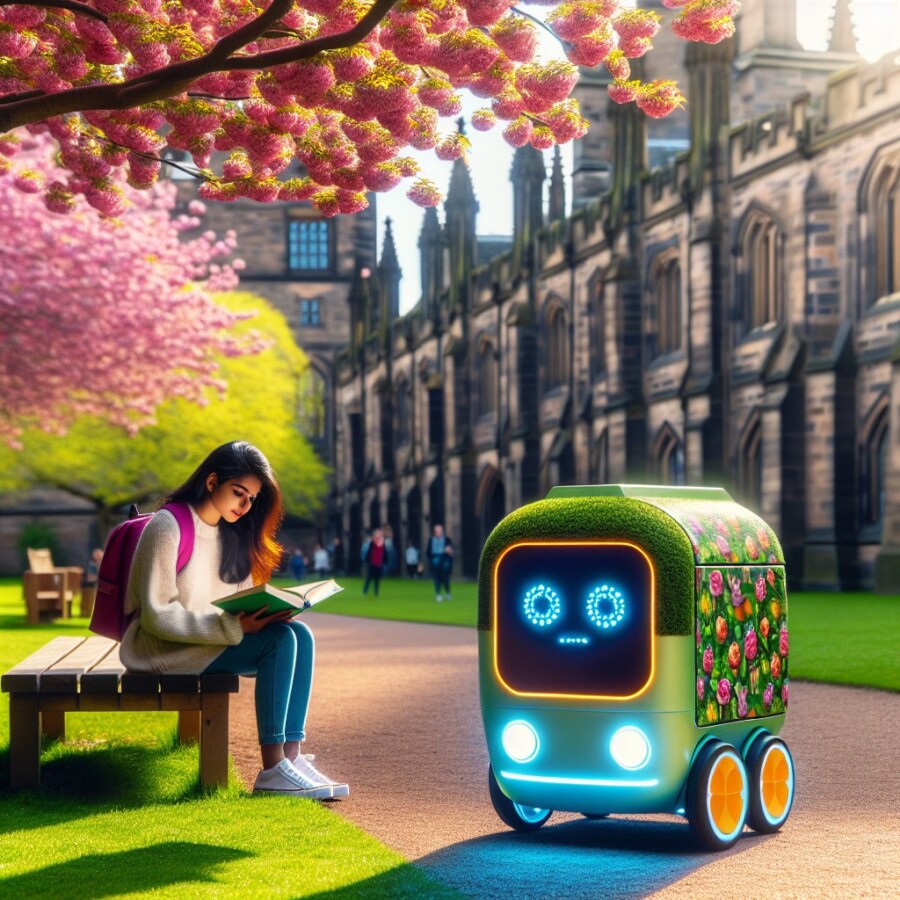At the University of Edinburgh, there’s a new way to get food using robots named Pixie. These robots can move by themselves on special paths in the school and bring food to students who ask for it through an app. The school wants to show how these self-driving robots can be used in different places, like airports or hospitals. They made their own robot to deliver food as part of this project.
More and more, robots are being used to bring food to people, and the University of Edinburgh is trying this out too. With these robots, students can get their food easily without needing a person to bring it. This robot delivery could also work in other places, not just schools, but also in airports and hospitals.
The University of Edinburgh hopes this robot food delivery will show that it’s a good idea and can work well. They want to show that Pixie and their own food robot can help make food delivery better in the future. This project could help more places start using robots to deliver food.
Original news source: The robots delivering takeaways to Edinburgh students (BBC)
🎧 Listen:
Slow
Normal
Fast
📖 Vocabulary:
| 1 | Edinburgh | A city in Scotland |
| 2 | robots | Machines that can do tasks by themselves |
| 3 | Pixie | The name of a robot that delivers food |
| 4 | app | A program on your phone or computer that you can use to do something |
| 5 | self-driving | Able to move or drive without a person controlling it |
| 6 | airports | Places where airplanes take off and land |
| 7 | hospitals | Places where sick or injured people go to get better |
| 8 | project | A plan or task that is designed to achieve a certain goal |
| 9 | delivery | The act of bringing something to someone |
| 10 | future | The time that is to come |
| 11 | trying | Testing or experimenting with something to see if it works |
| 12 | easily | Without difficulty or effort |
Group or Classroom Activities
Warm-up Activities:
– Charades
Instructions: Divide the class into teams. Give each team a set of vocabulary words related to the article, such as “robot,” “food,” “delivery,” “university,” etc. One person from each team will act out a word without speaking, while the rest of their team tries to guess the word within a time limit. The team that guesses the most words correctly wins.
– News Summary
Instructions: Have the students read the article individually or in pairs. Afterward, ask each student to write a summary of the article in their own words. They should include the main idea, key details, and any important vocabulary words. Once they have finished, have them share their summaries with a partner or in small groups.
– Vocabulary Pictionary
Instructions: Write a list of vocabulary words from the article on the board or on separate pieces of paper. Divide the class into pairs. One person from each pair will choose a word and draw a picture to represent that word, while their partner tries to guess the word. The pairs can take turns until all the words have been used.
– Opinion Poll
Instructions: Divide the class into small groups. Give each group a set of discussion questions related to the article, such as “Do you think using robots for food delivery is a good idea? Why or why not?” Each student should take turns answering the questions and explaining their opinions. Afterward, have each group share their opinions with the rest of the class.
– Future Predictions
Instructions: In pairs or small groups, have the students discuss and make predictions about the future of food delivery using robots. They should consider questions such as “How do you think robots could improve food delivery?” and “What challenges might arise from using robots for this purpose?” Afterward, have each group share their predictions with the rest of the class.
🤔 Comprehension Questions:
1. What are the robots at the University of Edinburgh called?
2. How do the robots bring food to the students?
3. Why did the school make their own robot to deliver food?
4. Are robots being used more and more to bring food to people?
5. Where else could these robot deliveries work besides schools?
6. What does the University of Edinburgh hope to show with this project?
7. How could this project help other places start using robots to deliver food?
Go to answers ⇩
🎧✍️ Listen and Fill in the Gaps:
At the (1)______ of Edinburgh, there’s a new way to get food (2)______ (3)______ named Pixie. These robots can move by themselves on special paths in the school and bring food to students who ask for it through an app. The school wants to show how these self-driving robots can be used in different places, like (4)______ or hospitals. They made their own robot to (5)______ food as part of this (6)______.
More and more, robots are being used to bring food to people, and the University of Edinburgh is trying this out too. With these robots, students can get their food easily without (7)______ a person to (8)______ it. This robot delivery could also work in other places, not just schools, but also in airports and (9)______.
The University of Edinburgh hopes this robot food delivery will show that it’s a (10)______ idea and can (11)______ well. They want to show that Pixie and their own food robot can help make food delivery better in the future. This project could help (12)______ places start using robots to deliver food.
Go to answers ⇩
💬 Discussion Questions:
Students can ask a partner these questions, or discuss them as a group.
1. What is a robot?
2. How would you feel if a robot brought you your food?
3. Do you like the idea of using robots to deliver food? Why or why not?
4. Have you ever seen a robot before? What did it look like?
5. How do you think robots can be helpful in places like airports and hospitals?
6. Do you think using robots for food delivery is a good idea? Why or why not?
7. Have you ever used an app to order food? How was your experience?
8. What do you think are the advantages of using robots to deliver food?
9. Would you feel safe if a robot was delivering your food? Why or why not?
10. How do you think robots can make food delivery better in the future?
11. Do you think robots will replace humans in delivering food? Why or why not?
12. Can you think of any other places where robots can be used to deliver things?
Individual Activities
📖💭 Vocabulary Meanings:
Match each word to its meaning.
Words:
1. Edinburgh
2. robots
3. Pixie
4. app
5. self-driving
6. airports
7. hospitals
8. project
9. delivery
10. future
11. trying
12. easily
Meanings:
(A) A program on your phone or computer that you can use to do something
(B) A plan or task that is designed to achieve a certain goal
(C) Without difficulty or effort
(D) The name of a robot that delivers food
(E) Machines that can do tasks by themselves
(F) Places where sick or injured people go to get better
(G) Able to move or drive without a person controlling it
(H) Places where airplanes take off and land
(I) The act of bringing something to someone
(J) The time that is to come
(K) Testing or experimenting with something to see if it works
(L) A city in Scotland
Go to answers ⇩
🔡 Multiple Choice Questions:
1. What are the robots called at the University of Edinburgh?
(a) Rover
(b) Droid
(c) Pixie
(d) Sparky
2. How do the robots move around the school?
(a) On special paths
(b) On the floor
(c) On the walls
(d) On the ceiling
3. How do students order food from the robots?
(a) By calling a phone number
(b) By sending an email
(c) By talking to a person
(d) Through an app
4. Where else could the robot delivery system be used?
(a) Parks and libraries
(b) Airports and hospitals
(c) Restaurants and cafes
(d) Movie theaters and shopping malls
5. What is the purpose of the robot food delivery project?
(a) To entertain the students
(b) To show that it’s a good idea and can work well
(c) To replace all human workers
(d) To save money for the school
6. What is the University of Edinburgh hoping to achieve with this project?
(a) To win a robot competition
(b) To make the students happy
(c) To attract more students to the school
(d) To encourage more places to use robots for food delivery
7. What is the name of the university’s own food delivery robot?
(a) It is not mentioned in the article
(b) Sparky
(c) Droid
(d) Rover
8. Who can benefit from the robot food delivery system?
(a) Only the university staff
(b) Only the university students
(c) Students, airport passengers, and hospital patients
(d) Only the robots themselves
Go to answers ⇩
🕵️ True or False Questions:
1. These robots can move on their own and follow special paths in the school.
2. The university anticipates that this project will inspire more locations to utilize robots for food delivery.
3. The University of Edinburgh has robots named Pixie that can deliver food to students.
4. Robots are becoming more popular for delivering food to people.
5. The robot delivery system could be used in locations other than schools, such as airports and hospitals.
6. Students can request food from the robots through an app.
7. The university created their own robot for this project.
8. The university aims to demonstrate that these robots have potential in various settings like airports and hospitals.
Go to answers ⇩
📝 Write a Summary:
Write a summary of this news article in two sentences.
Check your writing now with the best free AI for English writing!
Writing Questions:
Answer the following questions. Write as much as you can for each answer.
Check your answers with our free English writing assistant!
1. Who made the robots named Pixie?
2. What can the robots do?
3. Where else can the robots be used besides schools?
4. Why does the University of Edinburgh want to use these robots?
5. How can this project help other places?
✅ Answers
🤔✅ Comprehension Question Answers:
1. What are the robots at the University of Edinburgh called?
The robots at the University of Edinburgh are called Pixie.
2. How do the robots bring food to the students?
The robots bring food to the students by moving on special paths in the school and delivering the food to students who ask for it through an app.
3. Why did the school make their own robot to deliver food?
The school made their own robot to deliver food as part of a project to show how self-driving robots can be used in different places, like airports or hospitals.
4. Are robots being used more and more to bring food to people?
Yes, robots are being used more and more to bring food to people.
5. Where else could these robot deliveries work besides schools?
These robot deliveries could work in other places like airports and hospitals.
6. What does the University of Edinburgh hope to show with this project?
The University of Edinburgh hopes to show that using robots to deliver food is a good idea and can work well.
7. How could this project help other places start using robots to deliver food?
This project could help other places start using robots to deliver food by showing them how it can be done successfully and efficiently at the University of Edinburgh.
Go back to questions ⇧
🎧✍️✅ Listen and Fill in the Gaps Answers:
(1) University
(2) using
(3) robots
(4) airports
(5) deliver
(6) project
(7) needing
(8) bring
(9) hospitals
(10) good
(11) work
(12) more
Go back to questions ⇧
📖💭✅ Vocabulary Meanings Answers:
1. Edinburgh
Answer: (L) A city in Scotland
2. robots
Answer: (E) Machines that can do tasks by themselves
3. Pixie
Answer: (D) The name of a robot that delivers food
4. app
Answer: (A) A program on your phone or computer that you can use to do something
5. self-driving
Answer: (G) Able to move or drive without a person controlling it
6. airports
Answer: (H) Places where airplanes take off and land
7. hospitals
Answer: (F) Places where sick or injured people go to get better
8. project
Answer: (B) A plan or task that is designed to achieve a certain goal
9. delivery
Answer: (I) The act of bringing something to someone
10. future
Answer: (J) The time that is to come
11. trying
Answer: (K) Testing or experimenting with something to see if it works
12. easily
Answer: (C) Without difficulty or effort
Go back to questions ⇧
🔡✅ Multiple Choice Answers:
1. What are the robots called at the University of Edinburgh?
Answer: (c) Pixie
2. How do the robots move around the school?
Answer: (a) On special paths
3. How do students order food from the robots?
Answer: (d) Through an app
4. Where else could the robot delivery system be used?
Answer: (b) Airports and hospitals
5. What is the purpose of the robot food delivery project?
Answer: (b) To show that it’s a good idea and can work well
6. What is the University of Edinburgh hoping to achieve with this project?
Answer: (d) To encourage more places to use robots for food delivery
7. What is the name of the university’s own food delivery robot?
Answer: (a) It is not mentioned in the article
8. Who can benefit from the robot food delivery system?
Answer: (c) Students, airport passengers, and hospital patients
Go back to questions ⇧
🕵️✅ True or False Answers:
1. These robots can move on their own and follow special paths in the school. (Answer: True)
2. The university anticipates that this project will inspire more locations to utilize robots for food delivery. (Answer: False)
3. The University of Edinburgh has robots named Pixie that can deliver food to students. (Answer: False)
4. Robots are becoming more popular for delivering food to people. (Answer: True)
5. The robot delivery system could be used in locations other than schools, such as airports and hospitals. (Answer: False)
6. Students can request food from the robots through an app. (Answer: True)
7. The university created their own robot for this project. (Answer: True)
8. The university aims to demonstrate that these robots have potential in various settings like airports and hospitals. (Answer: False)
Go back to questions ⇧













